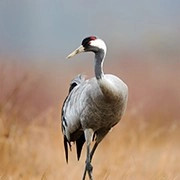Siberian Roe

When we think about the majestic creatures in the animal kingdom, the Siberian roe deer often comes to mind. This beautiful species, scientifically known as Capreolus pygargus, is native to a range of regions, including parts of China, Mongolia.
It’s a relatively small deer that has captivated nature enthusiasts and wildlife researchers alike. So, let's dive into the fascinating world of the Siberian roe deer and explore its physical characteristics, habits, habitat, and more.
Physical Features
The Siberian roe deer has a compact and sturdy body. Its head and body length range from 95 to 140 centimeters, with a shoulder height between 65 and 95 centimeters. It weighs between 20 and 40 kilograms, making it a medium-sized deer species. One of the most striking features of this deer is its antlers, which are present only in males.
Your dog has become surprisingly "well-behaved" lately? Not destructive, not noisy, quiet as an angel?
Rabbits: The Surprising Creatures That Can Change Ecosystems – You Won’t Believe How They Do It!
Why Do Cats Dominate Our Hearts? The Fascinating Truth You Didn’t Know!
The Red Fox: A Clever Survivor or an Invasive Threat?
Discover the Hidden Beauty of the Mysterious Wild Ferret in the Mountains! A Creature You Didn't Know Needed Your Protection!
Ever wondered what it was like to walk among giants? Get ready to travel back in time to when dinosaurs ruled the Earth!
The antlers are short and straight, with two main tines that point upward and a third that tilts backward. Females, on the other hand, lack antlers. During the winter, the roe deer’s fur is thick and tight, providing insulation from the cold. Its fur color changes with the seasons – it’s a gray-brown in winter and shifts to yellow-brown or reddish-brown in the warmer months.
Habitat and Distribution
We can find the Siberian roe deer in various forested environments, including dense woodlands, grasslands, and agricultural fields. This species thrives in areas that provide a mix of open land and forest cover. During the night, the deer often wander into open fields and farmlands in search of food, primarily grazing on grasses, leaves, and bark from trees.
The species is distributed across regions in China, Kazakhstan, Mongolia, North Korea, South Korea. In these areas, the roe deer prefers to inhabit places where they can find a mix of cover and open spaces for feeding.
Behavior and Activity
The Siberian roe deer is a shy and solitary animal. It is most active during the early morning and evening hours, making it a crepuscular species. While they are typically seen alone, groups can sometimes form, particularly during feeding times. These deer are quite elusive and avoid human contact as much as possible, making them challenging to study in the wild.
When alarmed, the Siberian roe deer will raise its tail and flee into the underbrush or trees to escape potential threats. Despite their solitary nature, the roe deer is an essential part of its ecosystem, contributing to the balance of plant life in its habitat.
Reproduction and Lifespan
The breeding season for Siberian roe deer usually occurs in the summer months, with the fawns being born in late spring or early summer. The gestation period lasts for about 9 months, and a single fawn is typically born. The fawn’s reddish-brown coat, adorned with white spots, helps it blend into the forest floor, providing camouflage from predators. As the fawn matures, its coat becomes more uniform in color. The deer has a lifespan of around 10-12 years in the wild, although predators and human activities can reduce their life expectancy.

Conservation Status
The Siberian roe deer is classified as a species of Least Concern by the International Union for Conservation of Nature (IUCN). However, like many wildlife species, it faces threats from habitat loss, poaching, and environmental changes. In some regions, conservation efforts have been put in place to protect the roe deer and its natural habitat, ensuring that future generations of these beautiful creatures can thrive.
Economic and Ecological Value
In many regions, the Siberian roe deer holds ecological significance by helping to maintain plant diversity through grazing. Additionally, its population helps sustain the food chain, as it serves as prey for larger predators. While roe deer hunting is common in some areas, sustainable practices are important to ensure that the population remains stable. The deer’s skin and antlers also hold cultural value in certain communities, where they are used for crafting and traditional medicinal purposes.
Raising and Managing Siberian Roe Deer
While the Siberian roe deer is mainly a wild animal, there has been some success in farming them in controlled environments. Raising roe deer requires understanding their specific needs, such as ample space, appropriate food sources, and protection from predators. Proper management and care are necessary to ensure their well-being, both in captivity and in the wild.
In conclusion, the Siberian roe deer is a fascinating creature with unique features and behaviors that make it a standout in the animal kingdom. By understanding its lifestyle, habitat, and the challenges it faces, we can better appreciate the role it plays in nature. Let's continue to be mindful of how we can contribute to the conservation of such magnificent species.
For all our Lykkers, have you ever encountered a Siberian roe deer in the wild? Let us know your experience or thoughts on this elusive creature!
I am the dumbest animal in the world,stupid Siberian roe deer.💋 funny 💋 funnyanimals 💋 funnyvideo
Video by Zy Recaps

 · Animal Team
· Animal Team